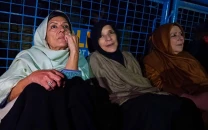Alopecia areata: The mane problem
For patients suffering from alopecia areata, all hope is not lost.

PHOTO: FILE
“It is an autoimmune disease [caused by] mostly internal factors rather than external ones. It is [an] unpredictable disease, but can be prevented by taking care of personal hygiene,” says assistant professor and consultant dermatologist, Dr Sadia Masood, at the Aga Khan University. “Good hygiene strengthens our immune system.”
“To prevent and avoid multiplication of the bald patches one should keep separate towels for the head and face as it can spread to the moustache, eyebrows and beard,” says Hakeem Rehan Alam, who has been running his clinic for several decades in Clifton and Federal B Area, Karachi. According to Alam, the disease is contagious and can spread from the scalp to other parts of the body.
But not all health experts are of the same opinion. According to Dr Naveed Ali Baloch, consultant dermatologist at the Institute of Skin Diseases in Regal, Saddar, alopecia areata has nothing to do with hygiene and can affect anyone, especially those with a family history of autoimmune disorders such as diabetes or thyroid disease. “It all depends on how the immune system reacts,” he says, adding that the disease is not contagious.
While many trace hair fall to stress, Alam claims, “This disease has nothing to do with it.” Dr Baloch also agrees, “One can suffer from stress as a result of hair loss but it’s not a cause.” According to Baloch, it is an uncommon disease and out of every 100 people, only one or two suffer from it. But Masood claims the numbers are slightly higher.
Although the disease affects both genders, more men suffer from it as compared to women. According to Masood, even children as young as two years can suffer from alopecia areata. While there is consensus on treatment, the disease can reoccur. “Around 90% of the people who are treated, do not suffer from the disease again,” says Baloch. In many cases the hair loss is reversed even without treatment by the end of the fourth or sixth month, or after a few years.
“One should follow a proper diet plan to prevent further patches on the scalp. Patches multiply if one continues eating beef, chicken, fish, eggs etc,” says Alam. Endorsing his treatment plan, Dr Shahnaz Alvi, who has been practicing homeopathy and running a clinic for 20 years, says, “A proper diet plan helps control the disease and prevents it from returning.” While a number of treatments are known to aid hair growth, they don’t necessarily work for all patients.
Types
The three types of this disease are; the commonly occurring alopecia areata in which smooth patches of various sizes occur only on the scalp, alopecia areata totalis which results in total hair loss on the scalp and alopecia areata universalis, the rarest form of the disease, in which the entire body experiences hair loss.
Ishrat Ansari works at The Express Tribune Karachi desk.
She tweets @Ishrat_ansari
Published in The Express Tribune, Sunday Magazine, March 9th, 2014.


















COMMENTS
Comments are moderated and generally will be posted if they are on-topic and not abusive.
For more information, please see our Comments FAQ